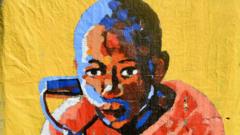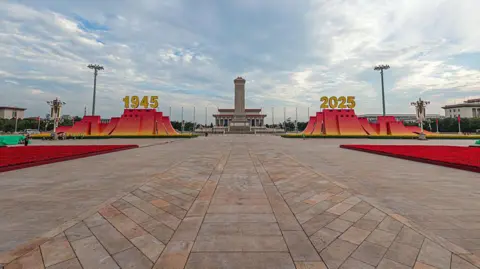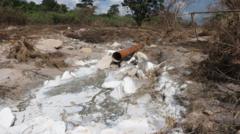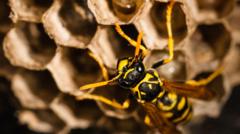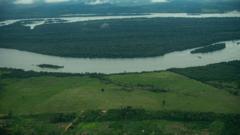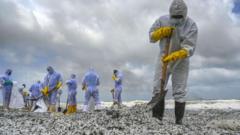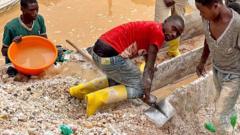In the heart of Zambia's Copperbelt, the notorious "black mountains" loom large, remnants of a century of unregulated mining and industrial waste. This stark landscape serves as both a literal and figurative backdrop for Stary Mwaba, a prominent visual artist who grew up in the area. Mwaba’s personal connection to these toxic dumps informs his latest exhibition at the Lusaka National Museum, where he creatively addresses the intersection of art and the socio-economic realities faced by local miners.
As he reflects upon his childhood, Mwaba recalls the warnings associated with the "black mountains," known locally as "mu danger." Yet, the allure of wild fruits and the promise of hidden treasures led many youths to explore these hazardous grounds. Today, young men venture into these towering heaps to extract fragments of copper ore, often selling their finds to Chinese buyers amid risky, illegal practices that sometimes lead to tragedy. Despite high unemployment rates in the region, for many, this dangerous work remains a crucial means of survival.
Mwaba's current body of work intricately weaves together vibrant portraits painted on old newspapers, exploring the personal stories of those who inhabit the shadow of the black mountains, particularly in the Wusakile neighborhood of Kitwe. Notably, these portraits reflect the experiences of miners supervised by "jerabos" (gang masters), revealing the stark contrast between the miners' struggles and the perceived criminality of their work.
The narratives represented in Mwaba's work are multifaceted. Each painting captures a moment of resilience and fragility, echoing the artist’s observation of life in Wusakile, where social activities revolved around church and community. The artworks portray not just the challenges of mining life but also moments of joy, like children playing on swings made from stripped electrical cables, symbolizing resourcefulness amid scarcity.
Mwaba’s artistic journey began unexpectedly in 2011, after a science project with his daughter led him to critically examine the influence of Chinese mining companies in Zambia. This exploration exposed him to the prevailing tensions surrounding foreign involvement in the local economy, compelling him to shift his focus towards portraying the people impacted by such operations.
His work aims to illuminate these "little narratives" that contribute to the larger societal picture. By using his platform to amplify their voices, he invites viewers to acknowledge the human stories often hidden beneath the surface of economic exploitation.
In reflecting on the broader implications of his art, Mwaba highlights a significant shift in his perception of the black mountains, from sites of childhood adventure to symbols of dire socio-economic realities. He captures the complex relationship locals have with these landscapes, drawing attention to how the very environments that once promised opportunity now impose harmful health consequences and perpetuate cycles of exploitation.
As Mwaba continues to facilitate workshops within the community, he fosters a sense of empowerment among the younger generation, hoping to inspire them to recognize their value beyond the burdens imposed by their environment. His artistic endeavors serve as both a critique of the systemic issues facing Zambia's Copperbelt and a celebration of the resilience of its people. Through his striking imagery, Mwaba illuminates the intertwined fates of those living in the shadow of Zambia’s mining legacy, reflecting on their past and the hope for a more sustainable future.
As he reflects upon his childhood, Mwaba recalls the warnings associated with the "black mountains," known locally as "mu danger." Yet, the allure of wild fruits and the promise of hidden treasures led many youths to explore these hazardous grounds. Today, young men venture into these towering heaps to extract fragments of copper ore, often selling their finds to Chinese buyers amid risky, illegal practices that sometimes lead to tragedy. Despite high unemployment rates in the region, for many, this dangerous work remains a crucial means of survival.
Mwaba's current body of work intricately weaves together vibrant portraits painted on old newspapers, exploring the personal stories of those who inhabit the shadow of the black mountains, particularly in the Wusakile neighborhood of Kitwe. Notably, these portraits reflect the experiences of miners supervised by "jerabos" (gang masters), revealing the stark contrast between the miners' struggles and the perceived criminality of their work.
The narratives represented in Mwaba's work are multifaceted. Each painting captures a moment of resilience and fragility, echoing the artist’s observation of life in Wusakile, where social activities revolved around church and community. The artworks portray not just the challenges of mining life but also moments of joy, like children playing on swings made from stripped electrical cables, symbolizing resourcefulness amid scarcity.
Mwaba’s artistic journey began unexpectedly in 2011, after a science project with his daughter led him to critically examine the influence of Chinese mining companies in Zambia. This exploration exposed him to the prevailing tensions surrounding foreign involvement in the local economy, compelling him to shift his focus towards portraying the people impacted by such operations.
His work aims to illuminate these "little narratives" that contribute to the larger societal picture. By using his platform to amplify their voices, he invites viewers to acknowledge the human stories often hidden beneath the surface of economic exploitation.
In reflecting on the broader implications of his art, Mwaba highlights a significant shift in his perception of the black mountains, from sites of childhood adventure to symbols of dire socio-economic realities. He captures the complex relationship locals have with these landscapes, drawing attention to how the very environments that once promised opportunity now impose harmful health consequences and perpetuate cycles of exploitation.
As Mwaba continues to facilitate workshops within the community, he fosters a sense of empowerment among the younger generation, hoping to inspire them to recognize their value beyond the burdens imposed by their environment. His artistic endeavors serve as both a critique of the systemic issues facing Zambia's Copperbelt and a celebration of the resilience of its people. Through his striking imagery, Mwaba illuminates the intertwined fates of those living in the shadow of Zambia’s mining legacy, reflecting on their past and the hope for a more sustainable future.

